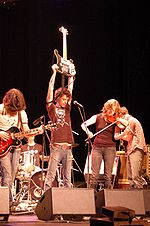Post-rock is a subgenre of alternative rock and progressive rock characterized by the use of instruments commonly associated with rock music, but using rhythms and "guitars as facilitators of timbre and textures" not traditionally found in rock. Post-rock musicians typically produce instrumental music.
Don Caballero and Tortoise were among the more prominent bands described as post-rock in the 1990s, but their styles are very different, despite being instrumental bands centered on guitars and drums. As such, the term has been the subject of backlash from listeners and artists alike.
Although firmly rooted in the indie or underground scene of the 1980s and '90s, post-rock's style often bears little resemblance musically to that of indie rock.
Origin of the term Post-rock
The term "post-rock" is believed to have been coined by critic Simon Reynolds in his review of Bark Psychosis' album Hex, published in the March 1994 issue of Mojo magazine. Reynolds expanded upon the idea later in the May 1994 issue of The Wire.
He used the term to describe music "using rock instrumentation for non-rock purposes, using guitars as facilitators of timbre and textures rather than riffs and power chords". He further expounded on the term,
| “ | Perhaps the really provocative area for future development lies... in cyborg rock; not the wholehearted embrace of Techno's methodology, but some kind of interface between real time, hands-on playing and the use of digital effects and enhancement. | ” |
Reynolds, in a July 2005 entry in his blog, claimed he had used the term "post-rock" before using it in Mojo, previously using it in music newspaper Melody Maker. He also said he later found the term to not be of his own creation, saying in his blog, "although I genuinely believed I was coining the term, I discovered many years later it had been floating around for over a decade." The term was used by American journalist James Wolcott in a 1975 article about musician Todd Rundgren, although with a different meaning. It was also used in theRolling Stone Album Guide to name a style roughly corresponding to "avant-rock" or "out-rock".
Another pre-1994 example of the term in use can be found in an April 1992 review of 90's noise-pop band The Earthmen by Steven Walker in Melbourne music publication Juke, where he describes a "post-rock noisiest".
Historical development
Early precedents
Post-rock appears to take a heavy influence from late 1960s U.S. group The Velvet Underground and their "dronology" — "a term that loosely describes fifty percent of today's post rock activity".
British group Public Image Ltd (PiL) were also pioneers, described by the NME as "arguably the first post-rock group". Their second album Metal Box (1979) almost completely abandoned traditional rock and roll structures in favor of dense, repetitive dub- and krautrock-inspired soundscapes and John Lydon's cryptic, stream-of-consciousness lyrics. The year before Metal Box was released, PiL bassist Jah Wobble declared, "rock is obsolete". Flowers of Romance (1981), their third album, was an even more radical departure, emphasizing rattling percussion and abstract tape music.
1990s post-rock
Bands from the early 1990s, such as Slint, or earlier, such as Talk Talk, were later recognized as influential on post-rock. Slint's Spiderland and Talk Talk's Laughing Stock are credited as giving birth to post-rock.
Originally used to describe the music of such bands as Stereolab, Laika, Disco Inferno, Moonshake, Seefeel, Bark Psychosis, and Pram, post-rock grew to be frequently used for a variety of jazz and krautrock influenced, largely instrumental, and electronica-tinged music made after 1994.
Groups such as Cul de Sac, Tortoise, Labradford, Bowery Electric and Stars of the Lid are cited as founders of a distinctly American post-rock movement. The second Tortoise LP Millions Now Living Will Never Die, made the band a post-rock icon. Many bands (e.g., Do Make Say Think) began to record music inspired by the "Tortoise-sound".
In the late 1990s, Chicago was the home base for a variety of post-rock associated performers. Both John McEntire of Tortoise and Jim O'Rourke of Brise-Glace and Gastr del Sol were important producers for many of the groups.
One of the most eminent post-rock locales is Montreal, where Godspeed You! Black Emperor and similar groups, including A Silver Mt. Zion, Do Make Say Think, and Fly Pan Am record on Constellation, a notable post-rock record label. These groups are generally characterized by an aesthetic rooted in, among other genres, musique concrète, chamber music, and free jazz.
Godspeed You! Black Emperor and Scottish group Mogwai were among some of the influential post-rock groups to continue their music career or end before the turn of the 21st century.
2000s post-rock
In the early 2000s, the term had started to fall out of favor. It became increasingly controversial as more critics outwardly condemned its use. Some of the bands for whom the term was most frequently assigned, including Cul de Sac, Tortoise, and Mogwai, rejected the label. The wide range of styles covered by the term, they and others have claimed, rob it of its usefulness.
Today, despite criticism of the term, post-rock has maintained its prominence. Sigur Rós, with the release of Ágætis byrjun in 1999, has become among the most well known post-rock bands of the 2000s. In part this has been due to the use of many of their tracks, particularly their 2005 single "Hoppípolla", in TV soundtracks and film trailers, including the BBC'sPlanet Earth. Their popularity can at least somewhat be attributed to a move towards a more rock oriented sound with simpler song structures and increasing utilization of pop hooks.Explosions in the Sky, This Will Destroy You, Do Make Say Think, Pelican, and Mono are some of the more popular post-rock bands of the 2000s. With a few exceptions, most notably Sigur Rós and Mogwai (album Mr.Beast in particular), the post-rock of the 21st century has generally eliminated vocals from its repertoire.
Musical characteristics
The post-rock sound incorporates characteristics from a variety of musical genres, including ambient, jazz, electronica, and experimental.Early post-rock groups also often exhibited strong influence from the krautrock of the '70s, particularly borrowing elements of "motorik", the characteristic krautrock rhythm.
Post-rock compositions often make use of repetition of musical motifs and subtle changes with an extremely wide range of dynamics. In some respects, this is similar to the music of Steve Reich, Philip Glass, and Brian Eno, pioneers of minimalism. Typically, post-rock pieces are lengthy and instrumental, containing repetitive build-ups of timbre, dynamics and texture.
Vocals are often omitted from post-rock; however, this does not necessarily mean they are absent entirely. When vocals are included, the use is typically non-traditional: some post-rock bands employ vocals as purely instrumental efforts and incidental to the sound, rather than a more traditional use where "clean", easily-interpretable vocals are important for poetic and lyrical meaning. When present, post-rock vocals are often soft or droning and are typically infrequent or present in irregular intervals. Sigur Rós, a band known for their distinctive vocals, fabricated a language that critics call "Hopelandic" ("Vonlenska" in Icelandic, a term even used by the band), which has been described by the band as "a form of gibberish vocals that fits to the music and acts as another instrument."
However, in lieu of typical rock structures like the verse-chorus form, post-rock groups generally make greater use of soundscapes. As Simon Reynolds states in his "Post-Rock" fromAudio Culture, "A band's journey through rock to post-rock usually involves a trajectory from narrative lyrics to stream-of-consciousness to voice-as-texture to purely instrumental music". Reynolds' conclusion defines the sporadic progression from rock, with its field of sound and lyrics to post-rock, where samples are stretched and looped.
Some bands, such as Rachel's and Clogs, combine post-rock with classical music, while others such as Godspeed You! Black Emperor and Fly Pan Am are so far removed frompopular music in their sparseness of arrangement and use of repetition, that they are frequently compared to minimalism.
Wider experimentation and blending of other genres have recently taken hold in the post-rock scene. Cult of Luna, Isis, Russian Circles and Pelican have fused metal with post-rock styles. The resulting sound has been termed post-metal. More recently, Sludge metal has grown and evolved to include (and in some cases fuse completely with) some elements of post-rock. This second wave of sludge metal has been pioneered by bands such as Giant Squid and Battle of Mice. This new sound is often seen on the label of Neurot Recordings.Similarly, bands such as Altar of Plagues, Lantlôs and Agalloch blend between post-rock and black metal, incorporating elements of the former while primarily using the latter. In some cases, this sort of experimentation and blending has gone beyond the fusion of post-rock with a single genre, as in the case of post-metal, in favor of an even wider embrace of disparate musical influences.





